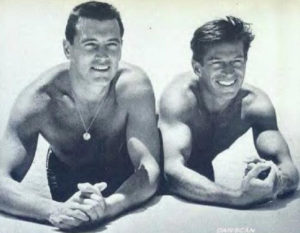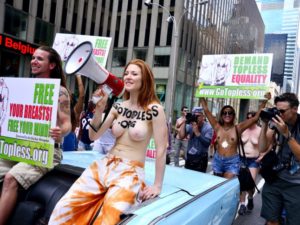
Trudeau, profiting from the parade
The irony of this parade is that the situation from decades ago is almost symmetrically inverted: now it is heterosexuality which is tolerated, of course, but it is expected from heterosexual majority not to display their orientation with too much pride since such display would be instantly qualified as heterosexist – heterosexuality is (not explicitly but subtly) perceived as a limitation, as a sexual orientation which is opportunistically satisfied with the old established patterns and avoids the risk to explore new liberating possibilities, as an impassive submission to the libidinal order imposed by the structure of social domination.
United Against Heterosexism
I fully experienced the truth of these lines in the afternoon of Sunday July 31, 2016, sitting in a hotel room in Vancouver and watching the live coverage of the Vancouver Pride Parade where, as the main media put it, “the power of love shined”: everyone was there, hundreds of thousands of people, either in the procession headed, as expected, by none other than the Canadian PM Justin Trudeau with his entire family who stole the show, or among the public observing the parade and warmly applauding it. (Such love, of course, has nothing whatsoever to do with the violent passion of authentic love, with the exclusive fixation on a singular being that totally derails our immersion into the rhythm of ordinary daily life. The “love” that shined at the parade was the stupid all-inclusive “oceanic feeling” for which Freud had no sense, a feeling that is ideology embodied, a feeling that obliterates all struggle and antagonism.) This big and all-inclusive display of “unity in diversity” of course needed an enemy – “heterosexism” was constantly evoked by the TV commentators who, of course, didn’t mean heterosexuality as such but merely the privileging of heterosexuality into a universal norm which reduces other sexual orientations to a secondary deviation.
Although this critical view of heterosexism pretends to be non-normative, open to every orientation, it, of course, subtly privileges non-heterosexual orientations – at least as less prone to ideological appropriation and more “subversive” with regard to hegemonic ideology. To paraphrase Mao, hundreds of flowers were blossoming: the parading groups encompassed not just queer and LGBT organizations but also libraries and bookstores, restaurants, theatres, lawyers, ecological groups, industrial and agricultural companies, up to a nightclub “always open to gays and trans…” – here is the official self-presentation of the organizers:
“There are approximately 150 parade entries — floats, dancers, marching groups and more — that make for a constant stream of entertainment along the three-hour route. Prepare to be wowed, amazed and inspired with sights such as four-foot-high headdresses, pink fire engines, more rainbow flags than you can count and signs conveying messages of hope and change. One of the most memorable parts of the parade are the costumes, which are so elaborate and outrageous that they make a feather boa and go-go boots look tame.”
Young men danced in small tights accentuating the contours of their penises, interrupting their dance only to passionately embrace and kiss, overweight boys and girls shamelessly displaying layers of fat hanging from their bellies (thereby subverting the sexist norms of beauty)… we were far from the situation decades ago when gays living in the shadowy underground, at best politely tolerated and ignored (one should nonetheless note that this marginalization and exclusion from public space gave birth to a surplus-enjoyment of its own: all the thrill of living in the half-forbidden shadowy space, of transgressing the predominant rules… We find among some in the LGBT community a contradictory desire of gaining full legitimacy in the public space and simultaneously enjoying the thrill of transgression). Such joyful public display is justified since heterosexism is still present in our everyday lives: by way of proudly displaying their orientation, queer people not only overcome their own reticence, they also make us, the observers, aware of our persisting prejudices confirmed by our uneasiness in observing their display.


First pic: Decades Ago (Rock Hudson with his friend);
Second pic: Now.
The irony of this parade is that the situation from decades ago is almost symmetrically inverted: now it is heterosexuality which is tolerated, of course, but it is expected from heterosexual majority not to display their orientation with too much pride since such display would be instantly qualified as heterosexist – heterosexuality is (not explicitly but subtly) perceived as a limitation, as a sexual orientation which is opportunistically satisfied with the old established patterns and avoids the risk to explore new liberating possibilities, as an impassive submission to the libidinal order imposed by the structure of social domination. “LGBT+” thus provided the specific colour of the entire field: although LGBT+ probably comprises no more than 10% of the population, they determined the colour of the entire field, all were united under their banner. (If we limit the population to those who effectively reject the two options of the standard gender identity and thus exclude trans, lesbians and gays who still experience themselves as women or men, we get around 1% of the population – and how can one not recall the Occupy Wall Street famous slogan of 99% against the 1% privileged wealthy? In the case of transgender people, (not legal but ethical) justice is on the side of the 1% against the 99% at ease with their gender identity.)
So “we are all queer”, although some are more than others. Such unity is of course by definition ideology at its purest, and we should immediately ask two questions: which is the form of subjectivity that underlies this unity, and who or what was de facto excluded (left unmentioned, ignored) from this bouquet of hundred flowers blossoming (to paraphrase Mao once again), or directly refused to participate? Many ethnic groups sat out in solidarity with Black Lives Matter Vancouver’s protest of the Vancouver pride parade for including a police float; many Indigenous people are members of BLM and thus de facto did not participate. Queer Muslim group Salaam and queer South Asian group Trikone were also sitting out this year’s pride parade; Salaam stated that »because of the racist backlash that we need to have our own march. /…/ Pride is not talking to us. The city is not talking to us.”

Muslim Queer group in a previous parade
These absences signal precisely the sites of social antagonisms, and we should include into this series actual transgender individuals themselves whose life full of anxieties and social uncertainties is far from the image of happy painted young men dancing half-naked and kissing.
For all these reasons, watching the Vancouver Pride Parade left a bitter taste in me (but also in many LGBTQ people) – it reminded me of many similar parades that I watched in my youth in the Communist Yugoslavia, working day parades where different collectives presented themselves celebrating their “unity in diversity” under the shared umbrella of the ruling ideology (brotherhood and unity of all nations in the self-management and non-aligned Socialist Yugoslavia). Even the subtle boredom and bureaucratic jargon of the TV commentators with its Politically Correct predictability (they were careful to designate the parade’s ideological umbrella with a version of the complex formula “LGBTQIA+”) reminded me of the similar jargon of the Communist commentators where every irony was prohibited.
As for the underlying form of subjectivity, we are clearly dealing with the sexualized version of the so-called post-traditional “protean subject”: today, the hegemonic form of subjectivity is no longer the autonomous subject subordinated to the paternal Oedipal Law which guarantees his (moral) freedom but the fluid subject that experiences itself as permanently reinventing and reconstructing itself, joyfully experimenting with combinations of different identities. The paradigmatic theorist of this new form of subjectivity is Judith Butler, and although she insists on its “subversive” character, it is easy to demonstrate that such a subjectivity rejecting any fixed identity and obsessed with permanent playful discursive reinvention fits perfectly contemporary consumerist and commodified society. This is why the obsessive attacks on patriarchy and Oedipal order sound so false and desperate: they attack an enemy that is in full retreat, reacting to something new which is already hegemonic. In short, the problem with this vision of a new fluid subjectivity is not that it is utopian but that it is already predominant – yet another case of the hegemonic ideology presenting itself as subversive and transgressive of the existing order. (The consequence to be drawn from all this is, of course, not to advocate a return to paternal symbolic authority as the only way out of the self-destructive deadlock of the late-capitalist narcissistic Protean Self, but to invent a new notion of subject, a subject which is really not so new since it is already here in philosophical modernity from the Cartesian cogito and Kant’s transcendental I. One should also doubt the accuracy of the clinical category of the post-Oedipal “Protean subject” – does it really move beyond Oedipus or does it continue to rely on the Oedipal logic?)

Pasolini, 60’s, “internal violence”
A more general remark on the fate of sexual liberation seems appropriate here. Graham Harman quotes a perspicuous remark on the 1960s – “You have to remember that the 1960s really happened in the 1970s.” –and comments on it: “an object somehow exists ‘even more’ in the stage following its initial heyday. The marijuana smoking, free love, and internal violence of the dramatic American 1960s were in some ways even better exemplified by the campy and tasteless 1970s.” If, however, one takes a closer look at the passage from 1960s to 1970s, one can easily see the key difference: in 1060s, the spirit of permissiveness, sexual liberation, counter-culture and drugs was part of a utopian political protest movement, while in the 1970s, this spirit was deprived of its political content and fully integrated inti the hegemonic culture and ideology. Consequently, the “even more” (which means: integration into the hegemonic ideology) was paid by an “much less” (depoliticization), and although one should definitely raise the question of the limitation of the spirit of the 19060s which rendered this integration so easy, the repression of the political dimension remains a key feature of the popular culture of the 1970s.


First pic: Easy Rider (1969): Real marijuana was used in drug scenes, not choppers but real people are into action.
Second pic: Vanishing Point (1971): Dodge Challenger is more into action than Barry Newman. Barry Newman rejects all marijuana offers, except in one scene.
For this reason, the idea to conceive of transgender identity as a »sinthom«, a constellation of signifiers that circulate around an empty centre, in Lacan’s sense is of no great use – it is either to general or too narrow. On the one hand, sinthom is for (late) Lacan the most elementary »formula« of enjoyment, providing the minimum of consistency to the libidinal edifice of every human being. On the other hand, Lacan reads Joyce’s literary texts as a sinthom, a synthetic formation which allowed him to avoid psychosis, i.e., which served him as a formation that supplemented the missing Name-of-the-Father – but I don’t think transgender individuals are potential psychotics who avoided psychosis by creating a sinthom…

The wound which doesn’t heal: “Sinthom” (Wagner’s Parsifal)
The ethical greatness of transgender subjects resides precisely in the fact that they reject “depersonalization” and remain subjects, assuming the deadlock of subjectivity even more radically than other more “normalized” subjects. Transgender subjects in no way subtract their space of enjoyment from intersubjectivity and practice their search for enjoyment in direct dealings with objects; their anxieties seem to concern precisely their position in social space. On the contrary, today’s consumerist capitalism does this subtraction quite well: instead of sex with persons, we have more and more sex with what Lacan calls lathouses, technologically created partial objects, all the »things that did not exist« prior to the scientific intervention into the real, from mobile phones to remote-controlled toys, from air conditioners to artificial hearts.
A Case of Pseudo-Struggle
The struggle between fundamentalism and permissiveness reached a new height (or, rather, low) when some French municipal authorities prohibited “burkinis” (a swimsuit that fully covers the body) on their beaches; symptomatically, three reasons were quoted: (1) burkini is a hygienic threat to the water on the beach; (2) it is a security risk since it can hide weapons; (3) it is incompatible with French secular culture. In a reaction to this “threat,” the French PM Manuel Valls praised the bare breasts of Marianne, the symbol of the French Republic and an icon of liberty and reason, as the opposite of burkini: “Marianne has a naked breast because she is feeding the people! She is not veiled, because she is free! That is the republic!” In short, Muslim women who wear the veil are not free, so the veil is anti-French, while bare breasts are emblematic of France: “French PM suggests naked breasts represent France better than a headscarf.» The barely covered obscenity of this line of argumentation was soon noted: is the attraction of Marianne with a bared breast (recall the famous Delacroix painting “Liberty Leading the People”) really grounded in the perception that she is feeding the people? As expected, the US engaged in this celebration of the alleged emancipatory potential of naked breasts in a more organized grass-root way – feminist groups in all big cities from San Francisco to New York organized “GoTopless Day protests« where hundreds of women walked along the streets with bared breasts to demand full equality, i.e., to display their rejection of yet another form of sexual segregation (men can walk around topless while women cannot do it):

“Free your breasts, free your mind”
»GoTopless Day always falls at the Sunday closest to Women’s Equality Day, Aug 26. It is indeed on Aug 26, 1920 that women earned their right to vote on the basis of Gender Equality. In 1971, the US Congress has made Aug 26 into a nationally recognized date and named it ‘Women’s Equality Day’. The president of the United States is summoned to commemorate this date each year. It is only logical that GoTopless Day protests (or celebrations depending on the legal status of your city) would fall around Women’s Equality Day since the right to go topless for women is based on gender equality as their right to vote once was. On Sunday Aug. 28, people in cities around the world are invited to stand up for women’s right to go topless in public. Please contact us if you would like to organize an event in your area so we can list your venue on our ‘Boob Map’ 2016.«
These parades promote “gender equality and women’s rights to bare their breasts in public” – as if the second is a natural implication of the first… and it goes without saying that if many of the women protesters were old and fat, and the display of their sagging bared breasts didn’t meet the established norms of beauty, this only added another point to the protest, the rejection of the heterosexual norms of beauty which objectify women. However, this go-topless movement should be analysed as part of a specific ideological constellation and not universalized into an emancipatory gesture. A couple of years ago, I was visiting some US campuses and giving talks there together with Mladen Dolar; the incident (for the two of us, at least) happened at a diner following our presentations. The professor informally chairing the event proposed that each of us sitting there (a dozen or so people) briefly introduces him- or herself, stating his professional position, the field of his work, and his or her sexual orientation. Our American colleagues did this as the most normal and obvious thing, while Dolar and me simply sidestepped the last issue. I was tempted to propose adding other features to this self-presentation: how much one earns per year and how much wealth one possesses (I am sure my US friends would find this much more intrusive than the question of sexual orientation…). In his own wonderful comment on this accident, Dolar evokes another experience:
“Some years ago, when some American friends were visiting Slovenia in summer, I took them to a beach on the Adriatic coast. It was a public and very crowded beach, and my friends were rather perplexed when they saw that the women, in large part, freely took their bras off, as it is commonly done in this part of the world, wondering around with bare breasts, while nobody made anything of it. My friends said this would never happen on a public beach in America (I have never been to one, so I take their word for it), they were rather embarrassed, despite their leftist liberal persuasions, feeling discomfort at what they saw as an edge of a deliberate public display and sexual provocation – as a European lack of reticence and discretion. It was almost like invoking a caricature ghost of Puritanism in the midst of this age of permissiveness. This gave rise to some musings about the question of the neighbor, that strange creature next to us whom we are supposed to love, but who causes embarrassment and mortification the moment s/he comes too close, intruding upon our private space, crossing the bar of discretion, exposing us, as it were, by exposing him/herself, exposing his or her intrusive privacy which thus cannot be kept at a proper distance.”
(Incidentally, in the last decade or so, the number of topless women on the beaches has diminished considerably – now, they are found only exceptionally. However, it would be wrong to read this change as a sign of conservative regression.) Far from being opposed or incompatible, the two features (declaring one’s sexual orientation and keeping one’s body covered) supplement each other within the universe of the US Puritanism which is, as we can see, well alive and kicking. That is to say, the way to account for such paradoxes is to bear in mind how the very indiscretion, surprising openness, can function as a tool of discretion, of withdrawal.

We are thus in the midst of another pseudo-struggle: burkini or bared breasts – this choice should definitely be depoliticized, left to the domain of the idiosyncrasy of personal preferences. That is to say, in spite of the emancipatory potential of the struggle for sexual freedoms, one should nonetheless become suspicious when the personal is declared political in the wrong way: when the direct display of one’s intimate preference becomes the ultimate political act. Authentic politics is never about publicly asserting what one is in the intimacy of one’s desires and fantasies. In other words, the Go-Topless movement is something like the Kardashians show in progressive politics. Kardashians brought the notion of fame to its self-referentiality: basically, they are thoroughly ordinary people who are famous for being famous. Even when their TV show touches a potentially hot political topic (as it happened with their visit to Cuba), their comments are strictly reduced to common sense platitudes like waving a hand at a passing child and shouting “Hi Cuba!” or commenting how in Cuba people know how to disconnect and enjoy peaceful life, while in the US they are all the time trying to achieve something.

Kim, visiting Cuba..
However, one should be more careful with Kim Kardashian. After she was tied up and robbed of her jewellery in a posh Paris hotel, the famed designer Karl Lagerfeld criticized her for being too flashy with her money. So she was partly to blame for the heist: she was “too public — we have to see in what time we live. You cannot display your wealth then be surprised that some people want to share it. If you are that famous and you put all your jewelry on the net you go to hotels where nobody can come near to the room.” Although I consider Kim Kardashian as a public figure embarrassingly tasteless, I find Lagerfeld’s comment disgusting – he is basically reproaching her for mixing with ordinary people, for not staying isolated from them. But if there is a redeeming feature of Kim, it is precisely her way of going out and mixing with her public. It is all too easy to make fun of the poor Kim – she is vulgar, her spontaneity is utterly faked, she is not just herself (what she really is), she rather PLAYS HERSELF (an ideal image of herself). It is all too easy to point out how her fame lacks any substance, how she is famous jus for being famous – but is it not that she just brings out a feature which is common to all “famous people” in our consumerist societies? Take what may appear to be the opposite of Kim, Angelina Jolie with all her humanitarian engagements directed at saving these or that victims. While Kim is mocked, Jolie is respectfully received by big political figures, and, as we recently learned from the media, in 2017 she will even teach at the prestigious London School of Economics (as a visiting professor on a graduate course called Women, Peace and Security). If anything, I find Jolie more problematic: while both Kim and Jolie participate in the culture of celebrity, Jolie wants to have her cake and eat it. She fully exploits the celebrity culture AND tries to obfuscate this fact by acting as an agent of “higher” causes. The true obscenity is not Kim’s shameless self-display, the true obscenity is Jolie offering herself as an authentic ethico-political figure. Making fun of Kim makes us forget that the stupidity projected into her is our shared substance. But what is the obscenity of poor Kim compared to the obscenity that pervades the big humanitarian celebrities? So what if despising Kim is an immanent part of her celebrity? What if the ideal consumer of her shows and news is not a naïve believer in her but a self-conscious consumer who knows very well how vulgar she is goes on avidly swallowing news about her enjoying the feeling of superiority that his knowledge gives him?
To be continued..
Footnotes:
1) I owe these data to Rebecca Carson, London.
2) See http://www.cbc.ca/news/canada/british-columbia/pride-parade-vancouver-protest-1.3694172.
3) Graham Harman, Immaterialism, Cambridge: Polity Press 2016, p. 122-3.
4) https://www.theguardian.com/world/2016/aug/30/france-manuel-valls-breasts-headscarf-burkini-ban-row.
5) Quoted from http://gotopless.org/gotopless-day.
6) Mladen Dolar, “The Art of the Unsaid” (unpublished paper).